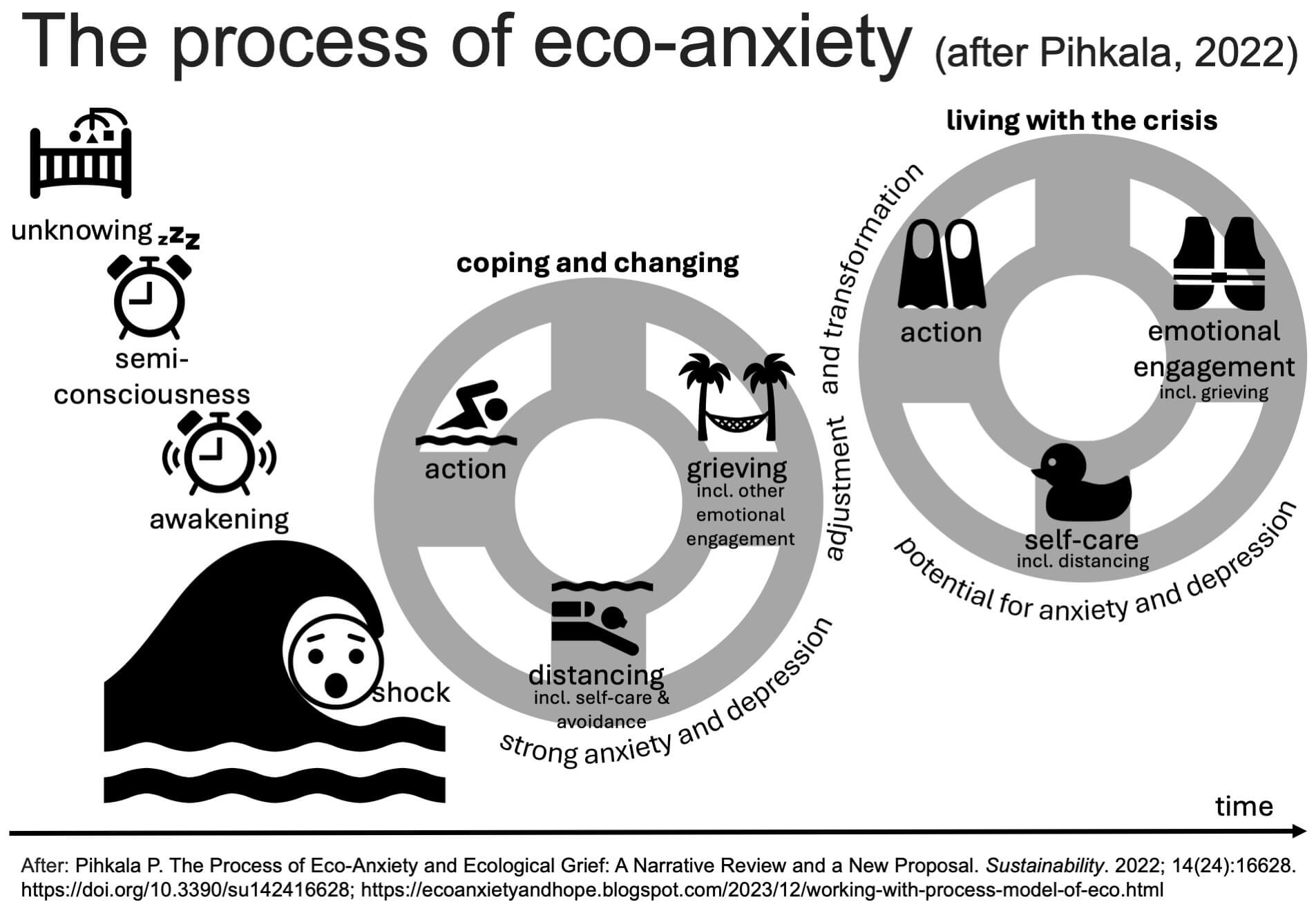
Pihkala (2022)’s Model for “The Process of Eco-Anxiety and Ecological Grief”
Today I found the model by Pihkala (2022) that I think can be helpful when thinking and talking about eco-anxiety (and that I, of course, had to recreate in order to fully think through — see above).
There are three main phases that are run through one after the other: Before awareness of the problem, then a strong anxiety and deep depression phase of coping and changing, and lastly living with the crisis.
Before. This phase consists of several steps. After the bliss of “unknowing”, of not being aware of the problem, which I visualise with a crib, comes a phase of semi-consciousness where people are aware that there is something but try to ignore it (like that alarm clock we try to ignore or snooze — this cognitive dissonance can be really unhealthy), but at some point we do wake up and then the enormity of the crisis hits us like a tsunami.
Strong anxiety and depression; coping and changing. Here, three modes co-exist: action (taking constructive action like joining demonstrations in order to swim and not sink), grieving (which can include also other emotions, like anger to not being able to experience a lifestyle like the parent generation did, and dealing with them for example in discussion groups) and distancing (which can be positive self-care like taking a day off from news, or negative avoidance like never looking at news to be able to live in denial — putting the head in the sand (or, in my picture, diving deep down)).
Through a process of adjustment and transformation, we lastly reach a stage where we can live with the crisis, and while there is a potential for anxiety and depression. The three modes here are similar to the ones in the previous phase, except that now they are conscious more explicitly managed by, for example, making sure that there is some engagement with emotions, and that self-care is constructive.
On their blog, Pihkala suggests a couple of reflection questions when using the model, e.g. “Where is the line between healthy self-care and problematic distancing, and how is this shaped by the various circumstances in which people live?“. This is a very interesting discussion that also came up in Marlis’ presentation about eco-emotions in relation to mindfulness. Pihkala also suggests a group activity where the different phases are laid out on the floor and participants move from phase to phase and reflect on their experiences and emotions with that phase.
I think this model can be very helpful when talking with students, acknowledging that eco-anxiety is very common (in her presentation, Marlis gave us some numbers…), and suggesting that there is a typical sequence of types of experiences and actions. It also helps to motivate any activities we might want to offer to deal with eco-anxiety — since it is such a common phenomenon, there is actually some experience on what can help with the “process of adjustment and transformation”, and there are also many suggestion for how to constructively deal with the three modes in the “living with the crisis” stage. Blogpost on those coming very soon!
Pihkala P. The Process of Eco-Anxiety and Ecological Grief: A Narrative Review and a New Proposal. Sustainability. 2022; 14(24):16628. https://doi.org/10.3390/su142416628
The Spiral of Silence, or why it is so difficult to talk about sustainability (updated) - Adventures in Oceanography and Teaching says:
[…] wants to bring down the mood, others or their own, or even provoke other strong emotions? Maybe understanding eco-anxiety and how to deal with it can help here, as well as just having the conversations despite the […]